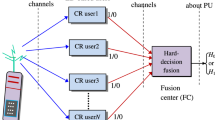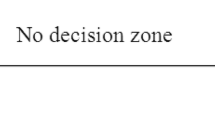Abstract
In cooperative spectrum sensing, local sensing at different sensing nodes is done either using soft decisions or hard decisions. The hard decision-based sensing has the advantage of using only one bit to report the local decision. In the literature, the hard decisions are combined at the fusion center using AND, OR, or MAJORITY rules. Although the problem of finding the “optimal” fusion rule was addressed and solved for the soft decisions fusion, it was not solved in the hard-decisions sensing. The problem of calculating the local and global decision thresholds in hard decisions-based cooperative spectrum sensing is known for its mathematical intractability. Hence, previous studies relied on simple suboptimal counting rules for decision fusion in order to avoid the exhaustive numerical search required for obtaining the optimal thresholds. These simple rules are not globally optimal as they do not maximize the overall global detection probability by jointly selecting local and global thresholds. Instead, they try to maximize the detection probability for a specific global threshold. In this paper, a globally optimal decision fusion rule for Primary User signal detection based on the Neyman-Pearson (NP) criterion is derived. The algorithm is based on a novel representation for the global performance metrics in terms of the regularized incomplete beta function. Based on this mathematical representation, it is shown that the globally optimal NP hard decision fusion test can be put in the form of a conventional one dimensional convex optimization problem. A binary search for the global threshold can be applied yielding a complexity of \(\mathcal {O}(\log _{2}(N))\), where \(N\) represents the number of cooperating users. The logarithmic complexity is appreciated because we are concerned with dense networks, and thus \(N\) is expected to be large. The proposed optimal scheme outperforms conventional counting rules, such as the OR, AND, and MAJORITY rules. It is shown via simulations that, although the optimal rule tends to the simple OR rule when the number of cooperating secondary users is small, it offers significant SNR gain in dense cognitive radio networks with large number of cooperating users.








Similar content being viewed by others
References
Haykin, S. (2005). Cognitive radio: Brain-empowered wireless communications. IEEE Journal on Selected Areas in Communications, 23, 201–220.
Ghasemi, A., & Sousa, E. (2005). Collaborative spectrum sensing for opportunistic access in fading environments. In: First IEEE International Symposium on New Frontiers in Dynamic Spectrum Access Networks, pp. 131–136, Nov 2005.
Zhang, W., Mallik, R. K., & Letaief, K. B. (2008). Cooperative spectrum sensing optimization in cognitive radio networks. Proceedings of IEEE International Conference on Communications (ICC?8), pp. 3411–3415, May 2008.
Ma, J., Zhao, G., & Li, Y. (2008). Soft combination and detection for cooperative spectrum sensing in cognitive radio networks. IEEE Transactions on Wireless Communications, 7, 4502–4507.
Tsitsiklist, J. N. (1988). Decentralized detection by a large number of sensors. Mathematics of Control, Signals and Systems, 1(2), 167–182.
Quan, Z., Cui, S., Poor, H. V., & Sayed, A. H. (2008). Collaborative wideband sensing for cognitive radios. IEEE Signal Processing Magazine, 25(6), 60–73.
Hoballah, I. Y., & Varshney, K. (1986). Neyman–Pearson detection wirh distributed sensors, 1986. 25th IEEE Conference on Decision and Control, Syracuse University (pp. 237–241) Syracuse, NY Dec 1986.
Duan, D., Yang, L., & Scharf, L. L. (2012). Optimal local detection for sensor fusion by large deviatiob analysis. 20th European signal processing conference (EUSIPCO 2012) (pp. 744–748) Bucharest, Romania, 27–31 Aug 2012.
Shen, J., Jiang, T., Liu, S., & Zhang, Z. (2009). Maximum channel throughput via cooperative spectrum sensing in cognitive radio networks. IEEE Transactions on Wireless Communications, 8(10), 5166–5175.
Chen, Y. (2010). Analytical performance of collaborative spectrum sensing using censored energy detection. IEEE Transactions on Wireless Communications, 9(12), 3856–3865.
Shen, J., Liu, S., Zeng, L., Xie, G., Gao, J., & Liu, Y. (2008). Optimisation of cooperative spectrum sensing in cognitive radio network. IET Communications, 3, 1170–1178.
Chaudhari, S., Lunden, J., Koivunen, V., & Poor, H. V. (2012). Cooperative sensing with imperfect reporting channels: Hard decisions or soft decisions? IEEE transactions on Signal Processing, 60, 18–28.
Aleki, S., & Leus, G. (2013). Censored truncated sequential spectrum sensing for cognitive radio networks, selected areas in communications. IEEE Journal on Selected Areas in Communications, 31(3), 364–378, March 2013.
Fragkiadakis, A. G., Tragos, E. Z., & Askoxylakis, I. G. (2012) A survey on security threats and detection techniques in cognitive radio networks. IEEE Communications Surveys & Tutorials, 15(1), 428–445.
Axell, E., Leus, G., Larsson, E. G., & Poor, H. V. (2012). Spectrum sensing for cognitive radio : State-of-the-art and recent advances. IEEE Signal Processing Magazine, 29(3), 101–116.
Chu, Y., & Liu, S. (2012). Hard decision fusion based cooperative spectrum sensing over nakagami-m fading channels. In 8th International Conference on Wireless Communications, Networking and Mobile Computing (WiCOM). Shanghai.
Abramowitz, M., & Stegun, I. (1964). Handbook of mathematical functions with formulas, graphs, and mathematical tables, Dover Publications, ISBN 0-486-61272-4, 1964.
Sun, Y., Baricz, A., & Zhou, S. (2010). On the monotonicity, log-concavity and tight bounds of the generalized Marcum and Nuttall Q?functions. IEEE Transactions on Information Theory, 56(3), 1166–1186.
Karp, D., & Sitnik, S. M. (2010). Log-convexity and log-concavity of hypergeometric-like functions. Journal of Mathematical Analysis and Applications, 364(2), 384394.
Bagnoli, M., & Bergstrom, T. (2005). Log-concave probability and its applications. Economic Theory, Springer, 26(2), 445–469.
Boyd, S., & Vandenberghe, L. (2004). Convex Optimization. Cambridge: Cambridge University Press.
Acknowledgments
This publication was made possible by NPRP grant #[5-250-2-087] from the Qatar National Research Fund (a member of Qatar Foundation). The statements made herein are solely the responsibility of the authors.
Author information
Authors and Affiliations
Corresponding author
Rights and permissions
About this article
Cite this article
Alaa, A.M., Nasr, O.A. Globally Optimal Cooperation in Dense Cognitive Radio Networks. Wireless Pers Commun 84, 885–899 (2015). https://doi.org/10.1007/s11277-015-2666-x
Published:
Issue Date:
DOI: https://doi.org/10.1007/s11277-015-2666-x




